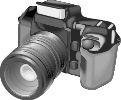Digital imaging technology has come a long way since Kodak scientists introduced the first commercial megapixel sensor in 1986. Shortly thereafter, in 1987, Kodak released a handful of products for recording, storing and printing “electronic still video images.” In 1990, Kodak developed the Photo CD system and proposed “the first worldwide standard for defining color in the digital environment of computers and computer peripherals.” The first professional digital camera, released in 1991, was the Nikon F-3, and was powered by a Kodak 1.3 megapixel sensor.
Over the last decade, the evolution of the digital camera has taken an enormous step forward. Today’s state-of-the-art digital SLRs boast quality and capability that rival those of traditional cameras. Costs of digital cameras, storage media and accessories are dropping significantly, making the technology more available to the general public.
Today’s digital cameras come even closer to eliminating guess work. A person needs only to point the camera and press a button and the camera does all the thinking on its own, producing crisp, high quality images that can be conveniently printed at home.
So does a digital camera automatically make someone a good photographer? Absolutely not. Good photography skills require time, experience, and artistic talent and has nothing to do with the camera.
So why are digital cameras suddenly so popular?
1) Results. Digital cameras provide instant results that can be viewed directly on the camera itself, printed instantly on properly equipped printers, or downloaded to the PC for viewing.
2) Quality. Digital cameras have caught up with film cameras in many instances, and in some areas, surpassed them.
3) Convenience. Sliding a media card into the camera is much easier (and faster) than trying to load a roll of film into a typical film camera.
4) Added Features. Many digital cameras can apply added effects to the photos as they are taken, such as sepia tone, enhanced color correction, grey scale, added sharpness, etc. without expensive lens filters.
Digital cameras, are not, however, necessarily superior to film cameras. In fact, neither is superior to the other in every instance. Not every digital camera is created equal, nor is every film camera the same. There are major trade-offs between the two types which must be taken into consideration, such as:
1) Higher power requirements. Digital cameras generally require higher power requirements than film cameras. Expensive batteries are often needed, which can entail frequent recharges.
2) High cost of equipment. Digital cameras and applicable accessories typically cost many more times than film-based equivalents.
3) Learning curve. Although the digital cameras of today are very easy to use, many still feel intimidated by their complexity.
4) Weight. Due to the additional electronic requirements, digital cameras tend to be heavier than their film equivalents, especially in larger, SLR models.
Have comments or suggestions for a weekly Tech Tips article? Send an email to webmaster@sunad.com.
Understanding Digital Cameras, Part I

